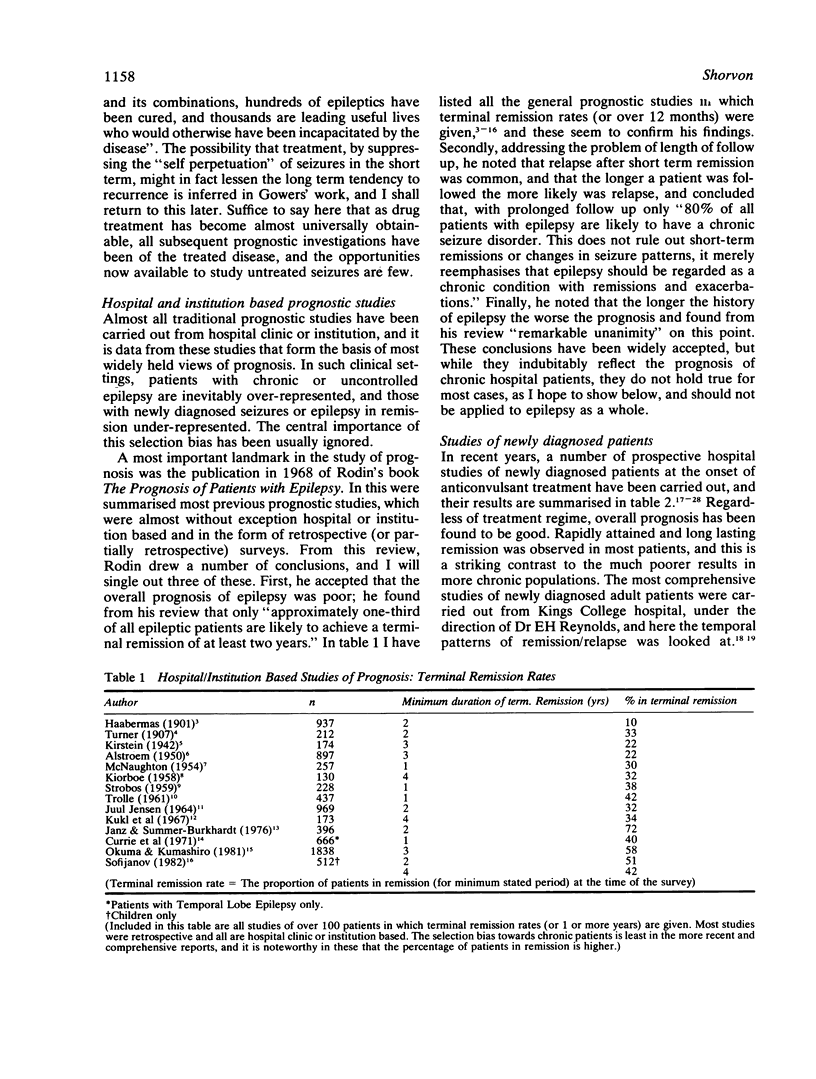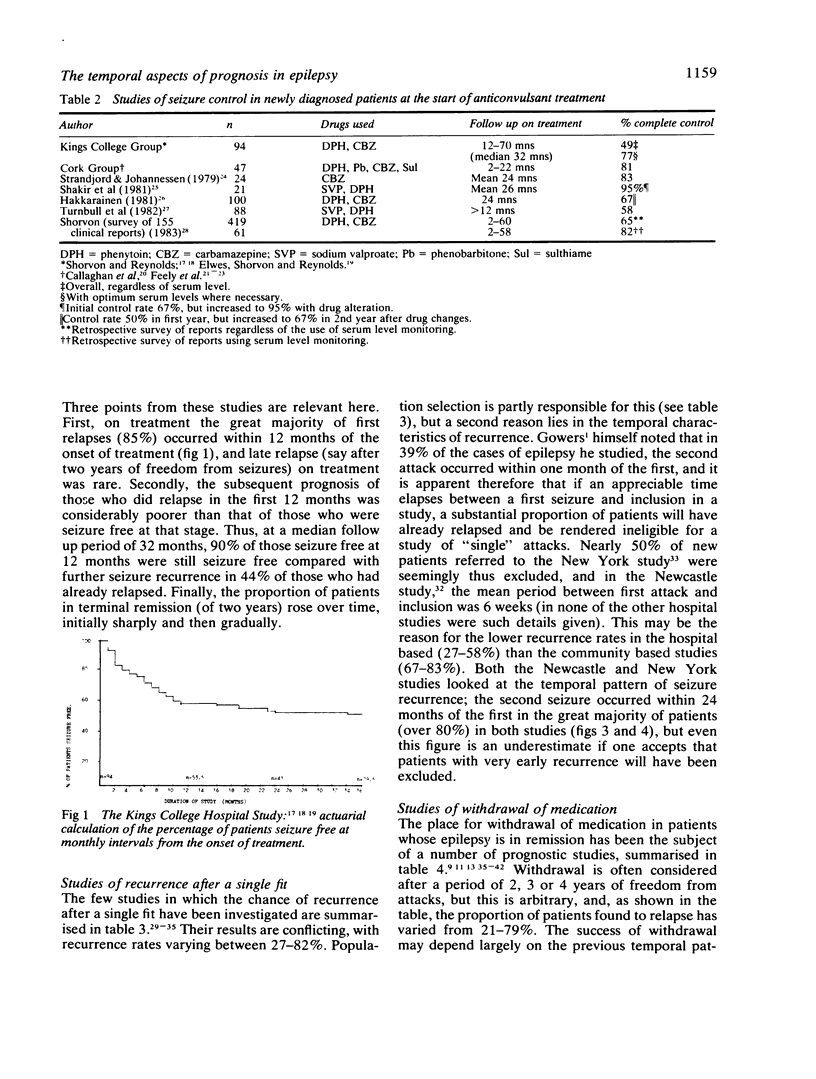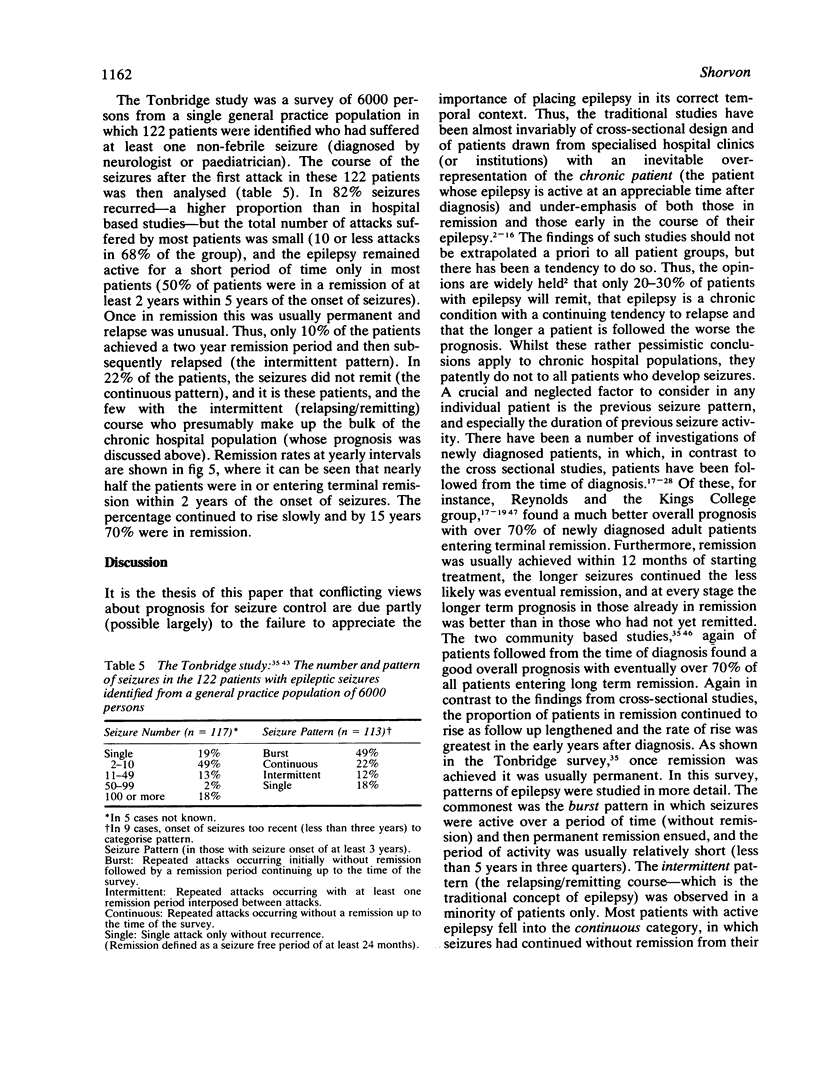Abstract
A major reason for the conflicting views concerning prognosis in epilepsy has been the failure to account for the temporal aspects of seizure relapse and remission. In this paper prognostic studies in a variety of areas are reviewed to emphasise this point. Most traditional studies (including studies of withdrawal of medication) show a generally poor prognosis for epilepsy. These have been hospital-based and, as such, inevitably over-represent patients with chronic epilepsy. Investigations (both hospital and community based) of patients from the onset of seizures show a much better prognosis, and most patients suffer only a small number of seizures in total over a relatively short period of time and then remit. The longer the epilepsy is active the less likely is eventual remission, but once remission is achieved it is usually permanent. The traditional view of epilepsy as a chronic condition with a continuing tendency to relapse is therefore not tenable for the majority of patients. The patterns of epilepsy are established relatively early in its course in most cases, and long term prognosis might therefore be predictable within a few years of the onset of seizures in most patients. Prior to the introduction of effective treatment, it was said that epilepsy rarely remitted, and it is possible that early treatment may actually improve long term prognosis.
Full text
PDF








Selected References
These references are in PubMed. This may not be the complete list of references from this article.
- Annegers J. F., Hauser W. A., Elveback L. R. Remission of seizures and relapse in patients with epilepsy. Epilepsia. 1979 Dec;20(6):729–737. doi: 10.1111/j.1528-1157.1979.tb04857.x. [DOI] [PubMed] [Google Scholar]
- Callaghan N., O'Callaghan M., Duggan B., Feely M. Carbamazepine as a single drug in the treatment of epilepsy. A prospective study of serum levels and seizure control. J Neurol Neurosurg Psychiatry. 1978 Oct;41(10):907–912. doi: 10.1136/jnnp.41.10.907. [DOI] [PMC free article] [PubMed] [Google Scholar]
- Cleland P. G., Mosquera I., Steward W. P., Foster J. B. Prognosis of isolated seizures in adult life. Br Med J (Clin Res Ed) 1981 Nov 21;283(6303):1364–1364. doi: 10.1136/bmj.283.6303.1364. [DOI] [PMC free article] [PubMed] [Google Scholar]
- Currie S., Heathfield K. W., Henson R. A., Scott D. F. Clinical course and prognosis of temporal lobe epilepsy. A survey of 666 patients. Brain. 1971;94(1):173–190. doi: 10.1093/brain/94.1.173. [DOI] [PubMed] [Google Scholar]
- Emerson R., D'Souza B. J., Vining E. P., Holden K. R., Mellits E. D., Freeman J. M. Stopping medication in children with epilepsy: predictors of outcome. N Engl J Med. 1981 May 7;304(19):1125–1129. doi: 10.1056/NEJM198105073041902. [DOI] [PubMed] [Google Scholar]
- Feeley M., Duggan B., O'Callagan M., Callaghan N., Seldrup J. The therapeutic range for phenytoin--a reappraisal. Ir J Med Sci. 1979 Feb;148(2):44–49. [PubMed] [Google Scholar]
- Feely M. P., O'Callaghan M., O'Driscoll D., Callaghan N. Sulthiame in previously untreated epilepsy. Ir J Med Sci. 1982 Jun;151(6):175–179. doi: 10.1007/BF02940174. [DOI] [PubMed] [Google Scholar]
- Feely M., O'Callagan M., Duggan B., Callaghan N. Phenobarbitone in previously untreated epilepsy. J Neurol Neurosurg Psychiatry. 1980 Apr;43(4):365–368. doi: 10.1136/jnnp.43.4.365. [DOI] [PMC free article] [PubMed] [Google Scholar]
- Goodridge D. M., Shorvon S. D. Epileptic seizures in a population of 6000. I: Demography, diagnosis and classification, and role of the hospital services. Br Med J (Clin Res Ed) 1983 Sep 3;287(6393):641–644. doi: 10.1136/bmj.287.6393.641. [DOI] [PMC free article] [PubMed] [Google Scholar]
- Goodridge D. M., Shorvon S. D. Epileptic seizures in a population of 6000. II: Treatment and prognosis. Br Med J (Clin Res Ed) 1983 Sep 3;287(6393):645–647. doi: 10.1136/bmj.287.6393.645. [DOI] [PMC free article] [PubMed] [Google Scholar]
- Hauser W. A., Anderson V. E., Loewenson R. B., McRoberts S. M. Seizure recurrence after a first unprovoked seizure. N Engl J Med. 1982 Aug 26;307(9):522–528. doi: 10.1056/NEJM198208263070903. [DOI] [PubMed] [Google Scholar]
- Hauser W. A., Kurland L. T. The epidemiology of epilepsy in Rochester, Minnesota, 1935 through 1967. Epilepsia. 1975 Mar;16(1):1–66. doi: 10.1111/j.1528-1157.1975.tb04721.x. [DOI] [PubMed] [Google Scholar]
- Holowach J., Thurston D. L., O'Leary J. Prognosis in childhood epilepsy. Follow-up study of 148 cases in which therapy had been suspended after prolonged anticonvulsant control. N Engl J Med. 1972 Jan 27;286(4):169–174. doi: 10.1056/NEJM197201272860401. [DOI] [PubMed] [Google Scholar]
- JUUL-JENSEN P. FREQUENCY OF RECURRENCE AFTER DISCONTINUANCE OF ANTI-CONVULSANT THERAPY IN PATIENTS WITH EPILEPTIC SEIZURES. Epilepsia. 1964 Dec;5:352–363. doi: 10.1111/j.1528-1157.1964.tb03341.x. [DOI] [PubMed] [Google Scholar]
- Johnson L. C., DeBolt W. L., Long M. T., Ross J. J., Sassin J. F., Arthur R. J., Walter R. D. Diagnostic factors in adult males following initial seizures. A three-year follow-up. Arch Neurol. 1972 Sep;27(3):193–197. doi: 10.1001/archneur.1972.00490150001001. [DOI] [PubMed] [Google Scholar]
- Juul-Jensen P. Frequency of recurrence after discontinuance of anticonvulsant therapy in patients with epileptic seizures: a new follow-up study after 5 years. Epilepsia. 1968 Mar;9(1):11–16. doi: 10.1111/j.1528-1157.1968.tb04953.x. [DOI] [PubMed] [Google Scholar]
- KIORBOE E. The prognosis of epilepsy. Acta Psychiatr Scand Suppl. 1961;36(150):166–178. [PubMed] [Google Scholar]
- Kühl V., Kiorboe E., Lund M. The prognosis of epilepsy with special reference to traffic security. Epilepsia. 1967 Sep;8(3):195–209. doi: 10.1111/j.1528-1157.1967.tb04436.x. [DOI] [PubMed] [Google Scholar]
- Reynolds E. H., Elwes R. D., Shorvon S. D. Why does epilepsy become intractable? Prevention of chronic epilepsy. Lancet. 1983 Oct 22;2(8356):952–954. doi: 10.1016/s0140-6736(83)90462-2. [DOI] [PubMed] [Google Scholar]
- Rodin E., Klutke G., Chayasirisobohn S. Epileptic patients who are refractory to anticonvulsant medications. Neurology. 1982 Dec;32(12):1382–1384. doi: 10.1212/wnl.32.12.1382. [DOI] [PubMed] [Google Scholar]
- STROBOS R. R. Prognosis in convulsive disorders. Arch Neurol. 1959 Aug;1:216–225. doi: 10.1001/archneur.1959.03840020090011. [DOI] [PubMed] [Google Scholar]
- Saunders M., Marshall C. Isolated seizures: an EEG and clinical assessment. Epilepsia. 1975 Dec;16(5):731–733. doi: 10.1111/j.1528-1157.1975.tb04757.x. [DOI] [PubMed] [Google Scholar]
- Shakir R. A., Johnson R. H., Lambie D. G., Melville I. D., Nanda R. N. Comparison of sodium valproate and phenytoin as single drug treatment in epilepsy. Epilepsia. 1981 Feb;22(1):27–33. doi: 10.1111/j.1528-1157.1981.tb04330.x. [DOI] [PubMed] [Google Scholar]
- Shorvon S. D., Chadwick D., Galbraith A. W., Reynolds E. H. One drug for epilepsy. Br Med J. 1978 Feb 25;1(6111):474–476. doi: 10.1136/bmj.1.6111.474. [DOI] [PMC free article] [PubMed] [Google Scholar]
- Shorvon S. D., Reynolds E. H. Early prognosis of epilepsy. Br Med J (Clin Res Ed) 1982 Dec 11;285(6356):1699–1701. doi: 10.1136/bmj.285.6356.1699. [DOI] [PMC free article] [PubMed] [Google Scholar]
- Sofijanov N. G. Clinical evolution and prognosis of childhood epilepsies. Epilepsia. 1982 Feb;23(1):61–69. doi: 10.1111/j.1528-1157.1982.tb05053.x. [DOI] [PubMed] [Google Scholar]
- THOMAS M. H. The single seizures: its study and management. J Am Med Assoc. 1959 Jan 31;169(5):457–459. doi: 10.1001/jama.1959.03000220037008. [DOI] [PubMed] [Google Scholar]
- TROLLE E. Drug therapy of epilepsy. Acta Psychiatr Scand Suppl. 1961;36(150):187–199. doi: 10.1111/j.1600-0447.1961.tb08383.x. [DOI] [PubMed] [Google Scholar]
- Thurston J. H., Thurston D. L., Hixon B. B., Keller A. J. Prognosis in childhood epilepsy: additional follow-up of 148 children 15 to 23 years after withdrawal of anticonvulsant therapy. N Engl J Med. 1982 Apr 8;306(14):831–836. doi: 10.1056/NEJM198204083061403. [DOI] [PubMed] [Google Scholar]
- Turnbull D. M., Rawlins M. D., Weightman D., Chadwick D. W. A comparison of phenytoin and valproate in previously untreated adult epileptic patients. J Neurol Neurosurg Psychiatry. 1982 Jan;45(1):55–59. doi: 10.1136/jnnp.45.1.55. [DOI] [PMC free article] [PubMed] [Google Scholar]
- YAHR M. D., SCIARRA D., CARTER S., MERRITT H. H. Evaluation of standard anticonvulsant therapy in three hundred nineteen patients. J Am Med Assoc. 1952 Oct 18;150(7):663–667. doi: 10.1001/jama.1952.03680070033009. [DOI] [PubMed] [Google Scholar]
- ZENKER C., GROH C., ROTH G. Probleme und Erfahrungen beim Absetzen antikonvulsiver Therapie. Neue Osterr Z Kinderheilkd. 1957;2(2):152–163. [PubMed] [Google Scholar]


